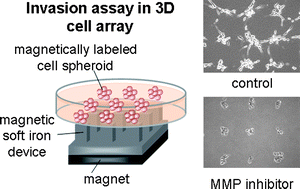Three-dimensional cell culture array using magnetic force-based cell patterning for analysis of invasive capacity of BALB/3T3/v-src
Abstract
A three-dimensional (3D) cell culture system has been fabricated using a magnetic force based cell

* Corresponding authors
a
Department of Biotechnology, School of Engineering, Nagoya University, Furo-cho, Chikusa-ku, Nagoya, Japan
E-mail:
honda@nubio.nagoya-u.ac.jp
b Division of Cancer Biology, Nagoya University Graduate School of Medicine, 65 Tsurumai-cho, Showa-ku, Nagoya, Japan
c MEXT Innovative Research Center for Preventive Medical Engineering (PME Center), Nagoya University, Furo-cho, Chikusa-ku, Nagoya, Japan
A three-dimensional (3D) cell culture system has been fabricated using a magnetic force based cell

 Please wait while we load your content...
Something went wrong. Try again?
Please wait while we load your content...
Something went wrong. Try again?
M. Okochi, S. Takano, Y. Isaji, T. Senga, M. Hamaguchi and H. Honda, Lab Chip, 2009, 9, 3378 DOI: 10.1039/B909304D
To request permission to reproduce material from this article, please go to the Copyright Clearance Center request page.
If you are an author contributing to an RSC publication, you do not need to request permission provided correct acknowledgement is given.
If you are the author of this article, you do not need to request permission to reproduce figures and diagrams provided correct acknowledgement is given. If you want to reproduce the whole article in a third-party publication (excluding your thesis/dissertation for which permission is not required) please go to the Copyright Clearance Center request page.
Read more about how to correctly acknowledge RSC content.
 Fetching data from CrossRef.
Fetching data from CrossRef.
This may take some time to load.
Loading related content
